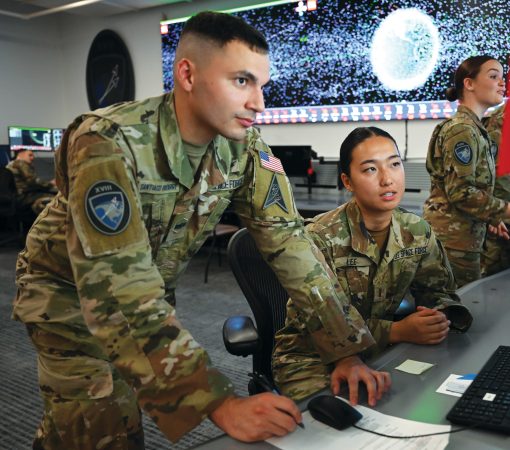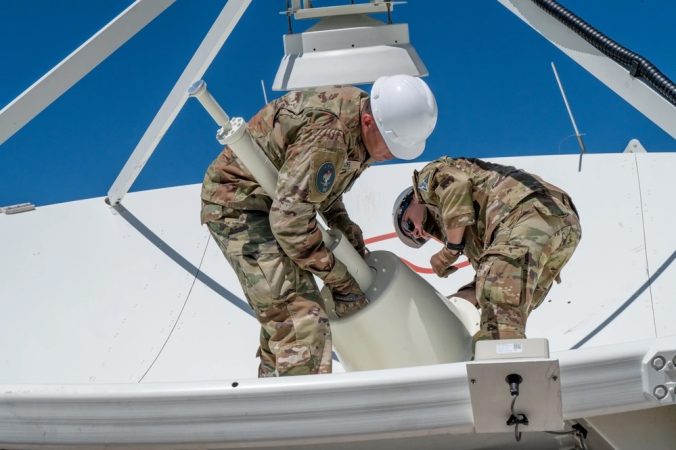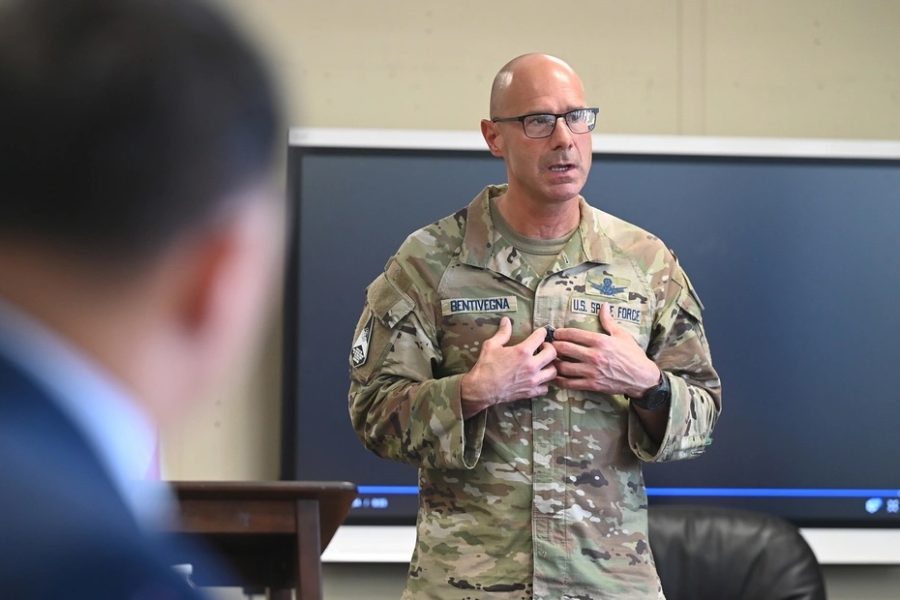NATIONAL HARBOR, Md.—The Space Force is too small for experienced non-commissioned officers to be anything short of elite, the top enlisted Guardian said at AFA’s Air, Space, and Cyber Conference on Sept. 23.
“We need Guardians who are subject matter experts, but we also need them to teach, to train, to mentor,” Chief Master Sergeant of the Space Force John Bentivegna said in his keynote address. “So there is no saying ‘I will be a technical subject matter expert, I want to do operations, I don’t want to lead.’ There is no such thing. We all lead at our levels. We all have influence over others.”
To cultivate those leaders and experts, Bentivegna rolled out a new “World-Class Master Sergeants” initiative during his speech—a framework for molding junior enlisted Guardians so that by the time they reach the rank of master sergeant, or the grade of E-7, they have years of technical expertise in their specialty; a deep understanding of how the service’s operational puzzle pieces fit together; and a commitment to developing and mentoring their junior colleagues.
Why focus on master sergeants? That rank is where Guardians are at the peak of their operational game before moving into more administrative roles as senior master sergeants or chief master sergeants, or E-8s and E-9s, respectively, Bentivegna said.
“The preponderance of where the warfighting work is being done is at the master sergeant level and below,” he said in an exclusive interview with Air & Space Forces Magazine on Sept. 18. “If we focus on developing the right master sergeants, and that’s the goal of our development model, just naturally, we’ll have the right talent to create E-8s and E-9s.”
Master sergeants make up 12 percent of the 4,900-strong enlisted force, Bentivegna said. The “world-class” framework breaks down what’s expected of Guardians on their way to that rank.

The process begins during the recruitment process, which Bentivegna said is being transformed into a scouting process where the Space Force proactively seeks out talent rather than waiting for them to walk in through a recruiter’s door, he said. For guidance, the service plans to meet with Major League Baseball’s Washington Nationals to see how a pro sports team scouts top talent.
Looking to baseball for inspiration is something of a national pastime for top Space Force enlisted leaders. In his final keynote address in 2023, Bentivegna’s predecessor, Chief Master Sergeant of the Space Force Roger Towberman, played an extended clip from the 2011 film “Moneyball,” where a cash-strapped baseball manager uses a new approach to data to build a record-setting team out of overlooked players.
“Rather than wait for somebody to come to the Space Force, how do we go out and find the talent that we need,” Bentivegna said.
The molding continues at basic military training and tech school, where new Guardians learn the initial skills of their job specialty. Currently, enlisted Guardians go to one of three bases for tech school:
- Goodfellow Air Force Base, Texas, for intelligence training
- Keesler Air Force Base Miss., for cyber
- Vandenberg Space Force Base, Calif., for space operations
Bentivegna envisions a combined, foundational course for all enlisted Guardians, and someday he hopes all those tech schools will come together for Guardians on one campus where they learn not only their specialty, but also train together as a crew, just like they will at their operational assignments.
“The ultimate goal is to enable Guardians to train together and ultimately fight together,” the chief said, though at this point the idea is still conceptual and no decisions regarding specific locations or basing have been made.
Beyond training together, Bentivegna wants to ensure BMT and tech school are not “a cakewalk,” so that when Guardians complete those courses, it is a meaningful moment. Whether they are entering the Space Force with a high school diploma or a master’s degree, trainees need to understand that being a Guardian is about more than just achieving technical mastery, the chief said. It is about working as a team.
For an experienced cyber professional, for example, Bentivegna said, “rather than let you skip a class, how about you share your knowledge and expertise with your teammates? I’m a little less interested in individual accomplishment, and I want to know who’s going to raise the team and make the team great.”
When asked what that might look like as a formal expectation or evaluation criteria at BMT or tech school, the chief said it was not the kind of thing that easily lends itself to checklists.
“Every organization has expectations and standards. But the goal is for each Guardian to be the best version of themselves,” he said. “You can say ‘this is the minimum,’ but to challenge yourself to be the best version of the person you can be, I think that is a different conversation.”

‘You’ve Proven Yourself’
Today’s enlisted Airmen expect to be promoted from Airman to Airman 1st Class to Senior Airman after a set amount of time at their current rank (known as time-in-grade) and time-in-service. But Bentivegna wants to tie the rise of Guardians through the junior enlisted ranks more to capabilities and achievement and less to “arbitrary” timelines.
“When I visit an operations floor, and I have a young E-3 who is telling me about working their midnight shift on a Saturday, and they’re executing the mission on behalf of a combatant command, I’m so impressed with the responsibilities that they have,” he said. “I’m like, why are you still an E-3? You should be an E-4. You’ve earned that right, you’ve proven yourself able to do that.”
The chief wants the same principle to apply as Guardians take their first step into the noncommissioned officer corps when promoting from the E-4 rank of Specialist 4 to the E-5 rank of Sergeant. Earlier this year, the Space Force rolled out a new E-5 promotion system where the number of E-4s selected for E-5 is limited by only the talent of the applicant pool, rather than by annual caps of how many new Sergeants can be promoted and which required candidates be scored and ranked.
The new system allows commanders to select as many qualified Guardians as they feel are ready for the responsibility, and commanders seemingly embraced the new ability, selecting 96 percent of E-4s to promote—a far larger rate than that of the Air Force. This year, a central promotion board still evaluated the candidates before selections could be made, but Bentivegna said next year will do away with the board entirely.
“We now want to give that authority and responsibility down to tactical level command teams, where commanders know what they need, performance-wise,” he said.
At this point there are no plans to expand the fully qualified promotion system to other ranks, but the ‘World-Class” framework lays out Guardians’ roles and responsibilities as they mature. Sergeants will cut their teeth in tactical operations before moving into more of an operational leadership and technical subject matter expertise role as they promote to tech sergeant and master sergeant, by which point their skills and experience should be matched by their leadership and mentorship capabilities.

“Because of the size of the force, we are putting a lot of pressure, a lot of responsibility on our E-7s, and that should be the pinnacle of a successful career in the Space Force,” John Bentivegna said. “They strive and drive to be that credible subject matter expert who is respected as a master sergeant in the thick of it, leading operations and hands-on developing our Guardians.”
“Now of course our E-8s and E-9s are doing great work,” he added, “but we decided looking at the structure and the needs of the service, that the journey to get to master sergeant is probably the best investment from an enlisted development model that we can do at this time.”
The framework may not necessarily change day-to-day life for Guardians, Bentivegna said, but it does crystallize how they will be evaluated throughout their careers. There is no single path to success, but this provides a constellation to navigate by.
“Where it will become really impactful is during those mentorship and developmental discussions, where supervisors are setting expectations and goals for their individuals, and individuals are setting their own personal goals,” he said. “It’s arming supervisors and command teams with ‘what do I talk about’ when you come to me and say, ‘I’d like some career advice, I’d like some mentorship—what do you think I should be striving for next?’”
‘Greater Empowerment’
The ‘world class’ framework comes a year after Bentivegna laid out an enlisted Guardian career path at the 2024 Air, Space & Cyber Conference. The plan emphasized empowering qualified, responsible enlisted Guardians and keeping them on the operations floor longer in their career, rather than push them into management and backshop activities too soon and deprive the service of their technical expertise.
That emphasis was inspired in part by space operations in the Air Force, where Bentivegna observed officers performing tasks better suited for NCOs. Not so with the Space Force, which, at about 9,500 members, is less than three percent the size of the Active-duty Air Force.
“The size of the force does not allow us to follow the same type of organizational structure and force design that we used in the past,” the chief said. “What I think will be different for those sergeants, tech sergeants, and master sergeants from when I came up in this business will be much more ownership, much more responsibility on the day-to-day execution of the mission, and greater empowerment than I had.”
But the top levels of Space Force leadership can’t do it alone. Bentivegna called on Guardians at all levels to make the change happen.
“This is a unity of effort to build the future that we all know that we need,” he said in his keynote. “So my ask, my challenge to you is: help me with that, embrace that opportunity, embrace that responsibility, and make sure that every single Guardian knows what their experience should be like.”


